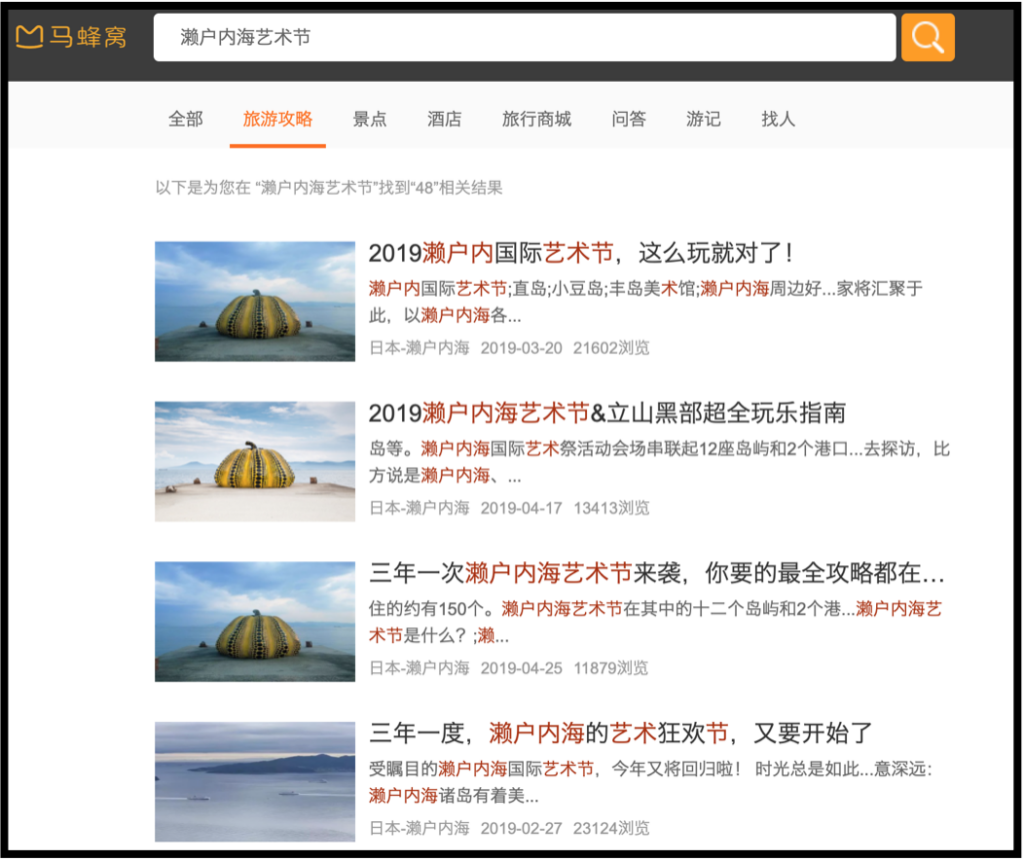The buzzwords for travel experiences in China today are cultural experiences. While many people are embracing museum tours as their go-to cultural activities, site-specific cultural events appeal to Chinese tourists as well, and are becoming another driver behind the this fast growing segment in the outbound Chinese tourism market.
Setouchi Triennale is a contemporary-art festival held every three years on remote islands in Japan. It aims to revitalize the Seto Inland Sea area, which was struggling with aging and depopulation issues. The previous edition of the Triennale was held in 2016. It attracted more than 1 million visitors from Japan and abroad. Among them, more than half of overseas visitors came from greater China area.
More over, Japan has been one of the top outbound travel destinations for Chinese tourists. According to a report released by China’s largest online travel agent Ctrip, the most popular Japanese destinations Chinese tourists visit are Tokyo, Osaka, and Okinawa. This list, however, does not include the remote islands where Setouchi Triennale takes place. What’s the draw to this rather out of the way art festival that’s quiet removed from any of Japan’s popular sightseeing to Chinese tourists?
“Visitors can admire high-level art works while looking at the beautiful scenery of the Seto Inland Sea, and learn about the local culture and history,” stated the Setouchi Triennale executive committee office in a email correspondence with Jing Travel, adding: “There are direct flights from Takamatsu Airport in Kagawa Prefecture to Shanghai, Taiwan, and Hong Kong, so in particular many visitors came from these flights.”
In a recent-released report by ITB China, the travel trade show foresees that needs for cultural travel in China are expected to grow by 30% or more in the coming next three years. Also, tourists in China have the highest willingness to pay for “experiencing the destination’s culture and understanding its history and customs.” Unlike the Venice Biennale, which appeals to Chinese visitors fluent in the art world, and where the artworks have little or no connection with the local community, the Setouchi Triennale attracts Chinese tourists with outdoor artworks resonating with local scenery and culture.
Last year, at a press conference in Beijing, in partnership with HUBART, a Chinese company promoting cultural events, the Setouchi Triennale invited the Chinese musician and artist Zhu Zheqin and the installation artist Xiang Yang to show in this year’s triennial. According to the report by Yicai, HUBART is also the partner of Echigo Tsumari Art Field — one of the world’s largest art festivals, which the Setouchi Triennale resembles in many ways.And now, to meet the growing needs for more cultural events in China, the government of Tonglu City, in Hangzhou province has signed an agreement with the curation team Art Front Gallery and HUBART to organize a local version of the Japanese art festival in 2020.

“Setouchi Triennale” search results on Mafengwo
The festival’s engagement with Chinese audiences goes online as well. For example, when you search the words “Setouchi Triennale” on Mafengwo, one of China’s most popular social media travel websites, there are more than 48 related search results and more than half of them are detailed travels and tips written by users. Surprisingly, there are very few articles specifically about Venice Biennale or other overseas art festival, let alone discussions. The same thing happens on other travel websites, such as Qyer, Qunar, and Ctrip and even other social media platform like Zhihu and Douban.

Chinese tourists at Mingyue village near Chengdu city Photo: Emily Zhang
This could be an extension of the trend for cultural tour wedded with art and local community in domestic travel. The town of Mingyue, which is 56 miles away from Chengdu in southwest China, was once a poor village without any tourism. In recent years, however, by introducing almost 40 creativity programs and collaborating with more than 100 artists and designers, this old village has become a very popular tourist destination. According to sohu.com, the village now attracts some 300,000 visitors every year, generating revenue of 300 million RMB through the creativity and travel business in 2019. From museums to a wide range of other cultural activities, China’s growing demand for more cultural travel experiences is projected to only increase, and that with that, lucrative business opportunities.



